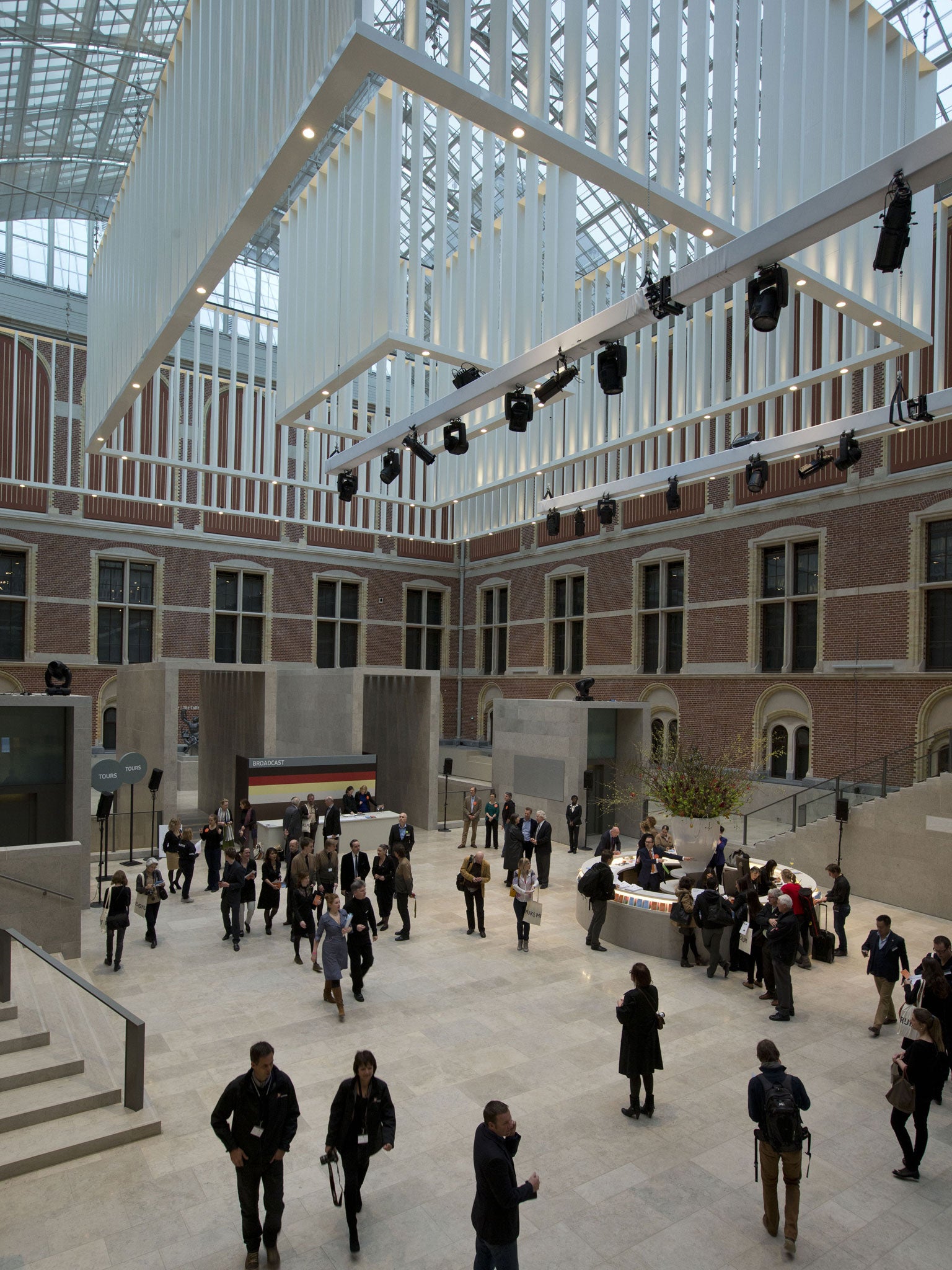Charles Darwent on the Rijksmuseum reopening: At last, the Dutch really do go Dutch
There's a very national flavour to the triumphant and long overdue relaunch of Holland's great museum. Just watch out for the bikes ....

To the ill-disguised joy of galleries the world over, the revamping of Amsterdam's Rijksmuseum has run years and many euros over budget. Now it is almost done. On Saturday, Queen Beatrix, in her last major act as Dutch monarch, will declare the remodelled museum open. As Head of the House of Oranje-Nassau, she will walk on an orange carpet; there will be a dozen fanfares to greet her, one from each province of the Netherlands. The Rijksmuseum is central to Dutch life, to the country's cultural imagining of herself, as no equivalent institution is in Britain.
So what will eager Hollanders find when the captains and the queens depart? Unexpectedly, perhaps, they will find a deal of Dutchness. When the museum closed for refurbishment in 2003, Amsterdammers were enraged that the cycle route under it was shut as well. Cycling is encoded in the Dutch genome: even Beatrix's mother rode a bike. So Hollanders are gripped by the thought that they will soon be able to ride through, rather than under, the Rijksmuseum, in a glassed-in roadway between its two new atriums. The importance of bicycles to the Dutch had, it seems, to be patiently spelled out to the Spanish architects of the museum's transformation, Messrs Cruz and Ortiz. The glazed cycle path is their transcultural masterstroke.
But the new Rijksmuseum will be Holland-centric in other, equally symbolic ways. The building houses the country's collections of fine and decorative arts, rather as if the National Gallery and the V&A were under one roof. Unlike those institutions, though, the Rijksmuseum's collections are nationally based.
Museums are both purveyors of historical objects and themselves objects of history, shaped by the fashions of their day. So, given the Rijksmuseum's Spanish architects and the fact that Wim Pijbes, its director, is young, has a background in film and theatre and was given carte blanche over what he would show and how he would show it, you might have expected a fashionably global slant to the museum's new hang.
This worry is dispelled as you walk towards The Night Watch. As before 2003, Rembrandt's masterpiece has the feel of an altar to Dutch genius at which the world is invited to worship. As before, the picture sits at the end of the sequence of rooms known as the Eregalerij, roughly translated as the Hall of Fame. As before, the occupants of this hall – Vermeer, Frans Hals, Jan Steen – are Golden Age Dutchmen.
At least as notable as the handsome storm-grey in which the Eregalerij's walls have been painted are the restored Neo-Gothic decorations of its original architect, Pierre Cuypers. Thought of as too Catholic for Protestant Holland when they were unveiled in 1876 – Cuypers was Holland's answer to Pugin – these were painted over in international whitewash in the mid-20th century. Now they are back, in a quiet reassertion of Dutch history.
If the new Rijksmuseum's national emphasis is a pleasant surprise, then so, too, is its hang. Press rumours had suggested that the broadly chronological organisation of this would be made up of a series of stijlkamers, re-creations of period rooms complete with ersatz wallpaper and dummies in ruffs. In fact, Pijbes's curators have interspersed occasional objects among the paintings in an entirely intelligent way.
Thus, in a room given over to pictures of Holland's 17th-century naval history, are the exquisite, contemporaneous scale model of a Dutch warship and a carved wooden coat of arms hacked from the stern of an British man-of-war by happy Dutch sailors during their raid on Chatham in 1667. Another room places gilt-framed portraits among inlaid marble tabletops, silverware and porcelain, locating paintings as luxury objects for the rich of mercantile Holland. Which, by and large, they were.
Are there any problems with the new Rijksmuseum? In a project of this scale, there would have to be. Ortiz and Cruz suffer from the unfortunate Spanish taste for grey marble; their twin atriums look like an abattoir, with the sound-baffling chandeliers as humane killers. The new hang is intended to bring the story of Dutch genius up to date, taking us from Rembrandt via Van Gogh and Mondrian to CoBrA. The newer the art, though, the more far-flung the gallery in which it is hung, which suggests an unfortunate falling-off in value. In any case, the Stedelijk and Van Gogh museums are metres away across the Museumplein, and do these things better.
But the new Rijksmuseum is a triumph for all that, and not simply for the Dutch and Dutchness. It shows that museums can reinvent themselves without stooping to cheap showmanship, can make their collections accessible without patronising the people who see them. Drie keer hoera – three cheers – to that.
Critic's Choice
The Courtauld Gallery, London, stages an exhibition dedicated to a single year in Picasso's life, when he launched his career in Paris before radically changing his style. Becoming Picasso: Paris 1901 brings together many of the major works from that time for a tightly focused, illuminating show (till 27 May). At Manchester Art Gallery for a year, Radical Figures: Post-war British Figurative Painting brings together Francis Bacon, Lucian Freud, David Hockney and others (to 16 Mar 2014).
Subscribe to Independent Premium to bookmark this article
Want to bookmark your favourite articles and stories to read or reference later? Start your Independent Premium subscription today.

Join our commenting forum
Join thought-provoking conversations, follow other Independent readers and see their replies